
Kovsh, 37.2 cm long
(Courtesy Sotheby’s)
The workshop was founded in 1865 by the silversmith master Stefan Väkevä (1833-1910), who shortly after qualifying as a master, became a supplier of silver objects to the jewelry firm of Gustav Fabergé, father of Karl Fabergé. From the late 1870’s Väkevä had a contract with Fabergé to work exclusively for him. This collaboration continued until 1917. Stefan Väkevä’s two sons, Konstantin (1867-1902) and Alexander (1870-1957), apprenticed with their father and qualified as master silversmiths in the early 1890’s. Both sons continued to work with their father in the family workshop. Each had his own master’s mark: ![]() and
and ![]() for Stefan,
for Stefan, ![]() for Konstantin,
for Konstantin, ![]() for Alexander.
for Alexander.
It was unusual for a family workshop, with three family members working under the same roof, to mark their production with their individual marks. To add to the confusion of three separate marks, a fourth mark was introduced after 1902 in the Väkevä workshop. Due to the premature death of Konstantin Väkevä, his widow Jenny Väkevä was left alone to support two small children. She was subsequently given the right to a mark of her own ![]() . This entitled her to an income from the workshop. The so-called ‘widow’s mark’, was apparently unique to Russia as part of traditions of the old Guild system. Terminated in Western Europe in the middle of the 19th century, the Guild system had permitted widows of masters to carry on their husbands’ workshops using his established marks. Russia seemingly took a further step in granting widows a mark of their own. This being one of the peculiarities of the system, as women at that time did not have the possibility to train in the craft, they were in other words not themselves master gold- or silversmiths.
. This entitled her to an income from the workshop. The so-called ‘widow’s mark’, was apparently unique to Russia as part of traditions of the old Guild system. Terminated in Western Europe in the middle of the 19th century, the Guild system had permitted widows of masters to carry on their husbands’ workshops using his established marks. Russia seemingly took a further step in granting widows a mark of their own. This being one of the peculiarities of the system, as women at that time did not have the possibility to train in the craft, they were in other words not themselves master gold- or silversmiths.
It should be observed that the term ‘master’ should not be confused with the word ‘workmaster’. A master (for the purpose of this discussion a gold- or silversmith master) was and still is the title of a craftsman who has qualified himself as a master, having passed the examinations required and having submitted a ‘master’s piece’ approved and endorsed by the Elders of the Guild. With the termination of the Guild system the approval and endorsement was taken over by goldsmith associations and educational institutions in the arts and crafts. ‘Workmaster’ defines the position of a master gold- or silversmith master in an enterprise. A ‘workmaster’, in other words, is the head of a workshop.
From the Väkevä workshop:

Champagne Cooler, 23 cm high
(Courtesy Christie’s Geneva 1985)
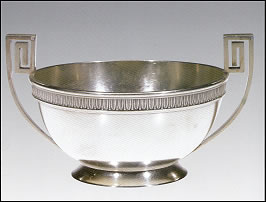
Sugar Basin, 7.75 cm high
(Courtesy Hodges Family Collection)
Russian Art
A Fabergé silver tankard, set with 13 coins and medallions of the Romanov emperors and empresses from Peter I to Nicholas II, sold for $110,500 (incl. the buyer’s premium). Ms. Rosa Strygler, a renowned philanthropist and art patron, has been actively involved in construction projects for camp Machne Gila on the East coast of the United States, and has generously donated these funds as seed money for a new Activities Center building campaign (Lot 259).
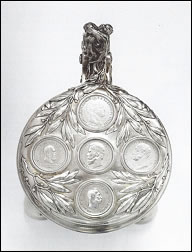
Top of Silver Tankard by Julius Rappoport
(Courtesy Sotheby’s New York)
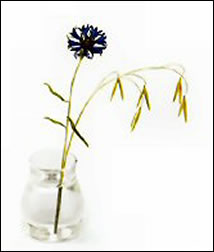
Fabergé Cornflower
Sold for a Record $662,500
(Courtesy Sotheby’s New York)
Christie’s London June 6, 2011
Russian Art
Featuring more than 40 works by Fabergé, the auction offered an Imperial presentation snuff-box given in 1894 to Charles Robert Carrington to commemorate his attendance at the funeral of Emperor Alexander III and the wedding of Emperor Nicholas II. Fifteen of the nineteen presentation snuff-boxes supplied by Fabergé during the reign of Nicholas II have either appeared on the market or are in important collections. The discovery of a documented, but previously unknown, snuff box is significant – this is the first appearance of the box on the auction market. Price realized $632,581.
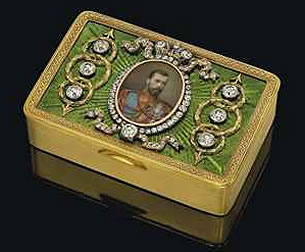
1984 Nicholas II Imperial Presentation Box
(Courtesy Christie’s London)
Works of Art, Fabergé and Icons
Three fans, rarely seen on the auction market, with Fabergé guards span the time period of 1895-1910. Two of them are from the workshop of Henrik Wigström, Fabergé’s third and last workmaster in St. Petersburg, and the third fan is by Oscar Pihl, a Moscow workmaster. Prices realized for lot 528 (Pihl) $14,136, and lots 529-530 (shown below) $81,441 and $83,441.
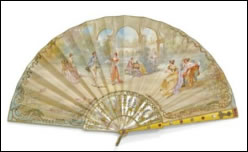
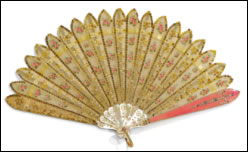
Wigström Fabergé Fans
(Courtesy Sotheby’s London)
The Russian Sale
A flexible diamond Fabergé bracelet inscribed ‘Armband (Fabergé) tillhört Marta Nobel-Oleinikoff Gåva till Görel Oleinikoff 11/12-71’ created in the workshop of August Holmström, St. Petersburg, ca. 1900, was bought by the Nobel family and has been in the family ever since.
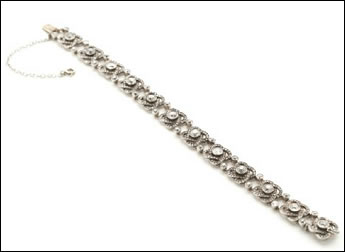
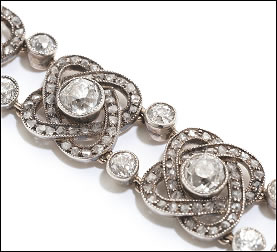
Nobel Bracelet
(Courtesy Bonhams London)
(Updates are posted in Exhibitions on the Fabergé Research Site)
Royal Fabergé
The exhibition coinciding with the Summer opening of Buckingham Palace explores how six successive generations of the British Royal Family, from Queen Victoria to Her Majesty the Queen and His Royal Highness The Prince of Wales, have shaped the finest collection of Fabergé in the world. A number of works are on public display for the first time, among them a miniature tea set originally belonging to Queen Alexandra enamelled to give the impression of porcelain, and a photograph frame containing official portraits of King George VI and Queen Elizabeth taken by Dorothy Wilding in 1946 to mark a tour of southern Africa the following year.
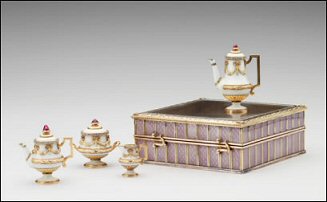
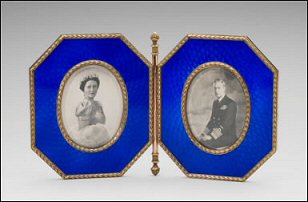
Miniature Teaset – Frame with 1946 Photographs
(Royal Collection © 2011, Her Majesty Queen Elizabeth II)
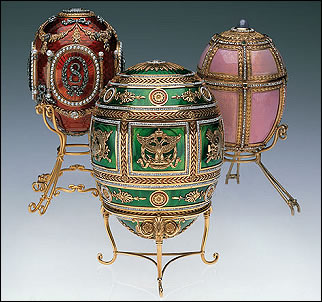
Imperial Easter Eggs
(Courtesy Cheekwood Botanical Garden and Museum of Art)
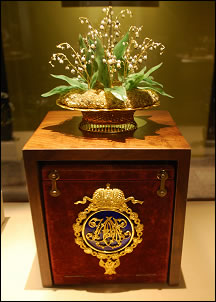
Lilly of the Valley Basket and
Its Presentation Basket
(Photograph George McCanless)
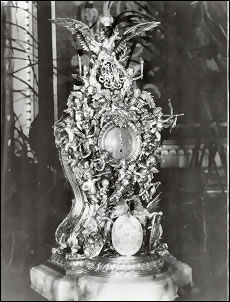
Alexander III 25th Wedding Anniversary Clock
von Dervis Exhibition, St. Petersburg
(1902)
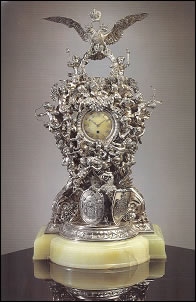
Missing the Monogram
(Christie’s New York, April 18, 1996, $1,652,000)
Houston Museum of Natural Science in Texas announced the Treasures from the Hermitage exhibition coming from St. Petersburg, Russia, has been cancelled due to legal issues.
Fabergé Revealed venue showcasing over 500 objects from four American collections will open in Richmond at the Virginia Museum of Fine Arts on July 9 and ends on October 2, 2011. It promises to be an exhibition not to miss!

Apple Blossom Eggs on a First Day Postcard, March 4, 2011
(Courtesy Philatelie Liechtenstein)
Katherine Purcell, whose well-known research of the French jeweler Alexis Falize (1811-1898), recently explored the fascination of Western goldsmiths and jewelers working in the Japanese style. She found a plethora of objects tracing the evolution of this art form, many of them shown in a Loan Exhibition in Aid of the Prince’s Trust (His Royal Highness The Prince of Wales). Catalog available from Wartski is entitled Japonisme: From Falize to Fabergé, The Goldsmith and Japan, 2011.
Fabergé Limited, a subsidiary of Pallinghurst Resources, is launching an art journal available exclusively as an iPad app on June 16, 2011. Called Mir Fabergé, the electronic art journal will bring together the work of contemporary artists as well as feature both original Fabergé objects and jewels created for the contemporary Fabergé High Jewellery Collections being sold by the subsidiary. The initial iPad offering includes illustrations and caricatures describing the Moscow discovery of a battered candy-tin containing Fabergé jewels on Solyanka Street in the 1990’s, and a reinterpretation of the original Fabergé Imperial Easter eggs in sketches and paintings by a modern artist.
A reader shared a prototype:
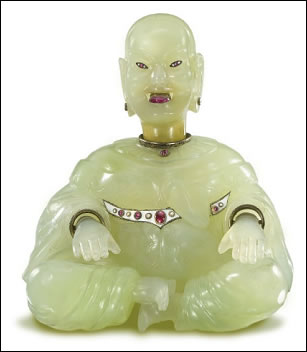
Fabergé Magot
(Courtesy Christie’s)

Delft 18th Century Magot
(Courtesy Piasa, Paris)
A 19th century French octagonal silver seal in the collection of James Hurtt is the same medallion cast in gold and used as the lid for two small nephrite boxes (1 1/4 inches high) made in the Perkhin workshop before 1896. A nephrite box lid set with diamonds and rubies (since 1947 in the Pratt Collection of the Virginia Museum of Fine Art in Richmond) appears to be identical to one sold at auction by Sotheby’s New York, June 13, 1990, lot 390.
The lid/medallion is cast from an 18th century medallion by the French engraver Pierre-Joseph Lorthior (1733-1813) in 1747 for the marriage of Louis d’Aumont, Duc d’Aumont (1732-1799) to Louise Jeanne de Durfort, Duchess de Marazin (1735-1781). The seal has French silver marks ca. 1890 and the same dimensions as the lids of the two Fabergé boxes. It is interesting to note the Fabergé firm would have purchased the medallions in Paris, and used them in these identical boxes. (Our thanks to James Hurtt for sharing his discovery.)

18th Century Seal by
Pierre-Joseph Lorthior
(Courtesy James Hurtt)
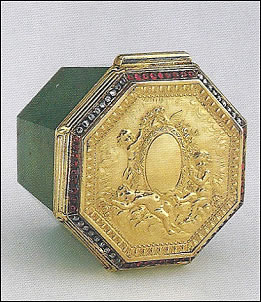
Octagonal Box
(Courtesy Virginia Museum of Fine Arts)
